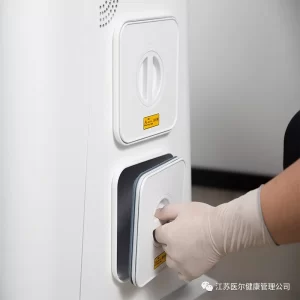Importance of Exhalation Valve Disinfection
The exhalation valve, as one of the important components of the ventilator, plays a key role. It is responsible for discharging the patient's exhaled waste gas to maintain normal respiratory function. However, many people may overlook the disinfection of the exhalation valve, which is actually a key step to ensure the safety of medical equipment.
Increased potential risk
The disinfection of the exhalation valve cannot be ignored because it is directly related to the life and health of the patient and the hygiene of the medical environment. If the exhalation valve is not disinfected regularly, the following problems may occur:
Increased risk of cross infection: The exhalation valve is at the outlet of the ventilator and is in direct contact with the patient's breathing. If the exhalation valve is not disinfected, microorganisms and pathogens exhaled by the patient may remain on the valve, increasing the risk of infection for other patients.
Degraded equipment performance: Blockage or contamination of the exhalation valve may cause the ventilator to perform poorly or even malfunction. This may have a negative impact on the patient's treatment.
Patient health risks: Contaminated exhalation valves may emit harmful gases or microorganisms, posing a potential threat to the patient's respiratory health.
The importance of prevention
Therefore, it is crucial to disinfect the exhalation valve regularly, which not only helps prevent cross infection, but also maintains the performance of medical equipment and ensures the safety of patients.
Next, we will introduce two commonly used exhalation valve disinfection methods in detail to ensure the hygiene and safety of medical equipment.
Disinfection methods
Method 1: High-temperature disinfection
High-temperature disinfection is an effective method that is suitable for many imported ventilators. However, it is worth noting that high-temperature disinfection also has some disadvantages. The specific steps are as follows:
Remove the ventilator exhalation valve.
Remove the metal diaphragm on the exhalation valve and place it in a clean and safe place.
Open the high-temperature disinfection device.
Place the exhalation valve in the high-temperature disinfection device.
Start the high-temperature disinfection program.
One of the disadvantages of high-temperature disinfection is that it requires special equipment, which may increase the operating costs of medical facilities. In addition, high-temperature disinfection takes a relatively long time, so it may have a certain impact on the availability of the ventilator.
Although high-temperature disinfection has some limitations, it is still an effective high-level disinfection method that can kill microorganisms lurking in the exhalation valve.
Method 2:
Anesthetic breathing circuit disinfection machine: one-button internal circulation disinfection
In addition to the disinfection of the exhalation valve, the entire ventilator also needs to be disinfected regularly to ensure the hygiene and safety of the equipment. The anesthesia breathing circuit disinfection machine combines the high-level disinfection method of ozone and compound alcohol to provide a convenient, fast and effective disinfection method.

Disinfection path cabin
The exhalation valve is one of the important components of the ventilator and plays a vital role. Its main function is to discharge the patient's exhaled waste gas, thereby maintaining normal respiratory function, ensuring that the patient can effectively inhale fresh air and expel carbon dioxide and other waste gases from the body. Through the effective exhalation process, the exhalation valve helps maintain the patient's gas exchange and avoids the retention of waste gas in the respiratory tract, which is essential for maintaining the patient's vital signs and overall health.
Although the exhalation valve plays such an important role in the ventilator system, many people often overlook the importance of disinfecting it. An exhalation valve that has not been fully disinfected may become a breeding ground for pathogens such as bacteria and viruses, thereby increasing the risk of infection for patients. Especially in medical institutions such as hospitals, ventilators usually need to be rotated between different patients. If the exhalation valve is not thoroughly cleaned and disinfected, the risk of cross-infection will be greatly increased.
Therefore, regular and thorough disinfection of the exhalation valve is a key step to ensure the safety and effectiveness of medical equipment. This is not only to protect the health of the patient, but also to extend the service life and performance of the ventilator equipment. The correct disinfection procedure usually includes the use of appropriate disinfectants, following strict disinfection time and methods, and regularly checking and maintaining the cleanliness of the equipment. Only in this way can we ensure that the exhalation valve is in the best condition every time it is used, providing the safest and most effective respiratory support for patients.
In summary, the disinfection of the exhalation valve is not only a necessary part of medical operations, but also an important measure to maintain patient health, avoid cross infection, and ensure the long-term operation of equipment. Medical workers should attach great importance to this link and ensure that every detail is not neglected in order to provide the best quality medical services.
